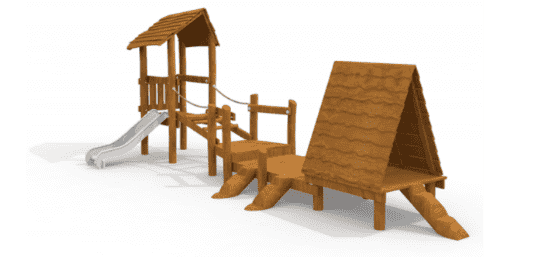Step 1: Designing with nature in mind
Let’s start with choosing a location that maximizes natural resources- trees providing shade, natural hills, or already existing bodies of water. Every element of the playground should be designed to fit into the surrounding nature without disturbing the local ecosystem..

Step 2: Environment-friendly materials
Let’s avoid plastic and other synthetic materials that could be difficult to recycle. Materials need to be safe for children as well as the environment. Our equipment is made out of wood that is resistant and durable as well as pleasant to the touch, easy to maintain and repair, and what’s most important - eco-friendly. All the wood used in the production of our playgrounds comes from sustainably grown forests.

.
Additionally, we offer products with the Nordic Swan Ecolabel certification. It’s a prestigious, internationally renowned Scandinavian reward, that guarantees the highest environmental and quality standard. Obtaining that certificate means our products meet the set of rigorous criteria regarding the choice of materials, production process, transportation, and recycling possibilities. By choosing our products, clients can be sure they are supporting our planet.
.
An example of a playground using Nordic Swan Eco Label products:
.

Step 3: Educational playgrounds
Joining playtime with education is crucial in shaping the environmental consciousness of children, Here is how we can achieve that on our playgrounds:
- Vegetable Garden It enables childrento observe the growth of plants from the roots, to see what is happening underground, it helps to build interest in nature from a young age.
- Bird Feeder: They allow for bird watching, feeding birds in winter, and recognizing different bird songs, bringing children closer to wild nature.
- Magnifying glass: This tool gives children the opportunity to closely observe flowers, leaves, and fruits, discovering their structure and beauty.
- Trash bins: Specially marked for waste segregation, these bins teach children the importance of proper waste management.

.
Step 4: Surface
Choosing the right surface for a playground is crucial in ensuring both safety and environmental sustainability. Sand and grass are popular options that provide numerous benefits for both children and nature.
Sand: Sand is one of the safest options for playground surfaces, especially under equipment where the risk of falling is greatest. The soft, flexible structure of sand excellently cushions falls, minimizing the risk of injury. Sand is also economical to purchase and easy to maintain. Regular sifting and replenishing ensure the surface remains hygienic and safe for extended periods. Additionally, sand encourages creative play and motor development in children, allowing them to build and dig.
Grass: Natural grass is another eco-friendly option that seamlessly integrates into the natural landscape. Grass is environmentally friendly, helping to regulate temperature and retain moisture in the soil. It is also safe for children, offering a soft and resilient surface that reduces the impact of falls. Maintaining grassy surfaces requires regular mowing and watering, but these efforts are a small price to pay for the benefits of natural greenery..
Both options, sand, and grass, have their place in an eco-friendly playground, where they harmoniously combine safety, comfort, and environmental education. By choosing sustainable surfaces, the playground becomes not only a place for fun but also a venue for learning about ecology and interacting with the natural environment.
.

.
An eco-friendly playground is not just a space for play but also serves as an inspiration for children and their families to act in favor of the environment every day. Celebrating Earth Day reminds us that every action, whether big or small, counts towards a sustainable future. It's these daily choices and actions that can lead to significant improvements in our environment.
















